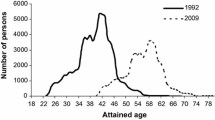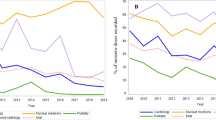Abstract
Radiation-induced risks for all solid cancer incidence and mortality were studied in the cohort of Russian Chernobyl emergency workers. The cohort included 69,440 persons with documented individual radiation dose accrued over the time of working in the Chernobyl zone. The mean age at entry into the zone of recovery operations was 33.9 years and accumulated radiation dose was 132.9 mGy. A total of 6981 solid cancer incident cases and 4272 deaths occurred in this cohort from 1992 to 2017. Three follow-up periods were studied: 1992–2009, 1992–2013, and 1992–2017. For each follow-up period, the lowest dose range with statistically significant (p < 0.05) radiation-induced risk of all solid cancer incidence and mortality were obtained. For the incidence of all solid cancer during the follow-up period 1992–2009, this lowest dose range was estimated to be 0–250 mGy with an excess relative risk per dose of ERR Gy−1 = 0.51 and 95% confidence interval (CI) (0.02; 1.05) Gy−1. For the period 1992–2013, the lowest dose range was 0–175 mGy with ERR Gy−1 = 0.85 (95% CI 0.03; 1.78), while for the whole follow-up period 1992–2017, it was 0–175 mGy with ERR Gy−1 = 0.81 (95% CI 0.08; 1.62). For mortality from all solid cancers during the follow-up period 1992–2009, the lowest dose range with statistically significant radiation-induced risk was estimated to be 0–225 mGy with ERR Gy−1 = 1.07 (95% CI 0.31; 0.97). For the period 1992–2013, the lowest dose range was 0–225 mGy with ERR Gy−1 = 0.86 (95% CI 0.23; 1.58), while for the whole follow-up period 1992–2017, the lowest dose range was 0–200 mGy with ERR Gy−1 = 0.82 (95% CI 0.10; 1.65). Thus, it was found that the minimal level of significant exposure (Dmin), for which a statistically significant radiation-induced risk of all solid cancers was obtained for Russian emergency workers (with individual doses of 0 – Dmin), decreases with increasing duration of cohort observation, both for cancer incidence and mortality.


Similar content being viewed by others
References
Breslow N, Day N (1987) Statistical methods in cancer research. Volume II. The design and analysis of cohort studies. Scientific publication 82. International Agency for Research on Cancer, Lyon, p 406
Cologne J, Preston DL, Grant EJ, Cullings HM, Ozasa K (2017) Effect of follow-up period on minimal-significant dose in the atomic bomb survivor studies. Radiat Environ Biophys 57(1):83–88
Grant EJ, Brenner A, Sugiyama H, Sakata R, Sadakane A, Utada M, Cahoon EK, Milder CM, Soda M, Cullings HM, Preston DL, Mabuchi K, Ozasa K (2017) Solid cancer incidence among the Life Span Study of atomic bomb survivors: 1958–2009. Radiat Res 187(5):513–537
International Commission on Radiological Protection (ICRP) (2007) The 2007 Recommendations of the International Commission on Radiological Protection. ICRP Publication 103. Ann ICRP 37(2–4)
Ivanov VK (2007) Late cancer and noncancer risks among Chernobyl emergency workers of Russia. Health Phys 93(5):470–479
Ivanov VK, Gorsky AI, Kashcheev VV, Maksioutov MA, Tumanov KA (2009) Latent period in induction of radiogenic solid tumors in the cohort of emergency workers. Radiat Environ Biophys 48(3):247–252
Ivanov VK, Tsyb AF, Khait SE, Kashcheev VV, Chekin SYu, Maksioutov MA, Tumanov KA (2012a) Leukemia incidence in the Russian cohort of Chernobyl emergency workers. Radiat Environ Biophys 51(2):143–149
Ivanov VK, Kashcheev VV, Chekin SYu, Maksioutov MA, Tumanov KA, Vlasov OK, Shchukina NV, Tsyb AF (2012b) Radiation-epidemiological studies of thyroid cancer incidence in Russia after the Chernobyl accident (estimation of radiation risks, 1991–2008 follow-up period). Radiat Prot Dosim 151(3):489–499
Kashcheev VV, Chekin SYu, Maksiutov MA, Tumanov KA, Kochergina EV, Kashcheeva PV, Shchukina NV (2015) Incidence and mortality of solid cancer among emergency workers of the Chernobyl accident: assessment of radiation risks for the follow-up of 1992–2009. Radiat Environ Biophys 54(1):13–23
Kesminiene A, Cardis E, Tenet V, Ivanov VK, Kurtinaitis J, Malakhova I, Stengrevics A, Tekkel M (2002) Studies of cancer risk among Chernobyl liquidators: materials and methods. J Radiol Prot 22(3A):A137–A141
Little MP, Muirhead CR (1996) Evidence for curvilinearity in the cancer incidence dose-response in the Japanese atomic bomb survivors. Int J Radiat Biol 70(1):83–94
Little MP, Muirhead CR (1997) Curvilinearity in the dose-response curve for cancer in Japanese atomic bomb survivors. Environ Health Perspect 105(Suppl. 6):1505–1509
Little MP, Muirhead CR (1998) Curvature in the cancer mortality dose response in Japanese atomic bomb survivors: absence of evidence of threshold. Int J Radiat Biol 74(4):471–480
Ozasa K, Shimizu Y, Suyama A, Kasagi F, Soda M, Grant EJ, Sakata R, Sugiyama H, Kodama K (2012) Studies of the mortality of atomic bomb survivors, Report 14, 1950–2003: an overview of cancer and noncancer diseases. Radiat Res 177(3):229–243
Preston DL, Lubin JH, Pierce DA (1993a) EPICURE User’s Guide. Hirosoft International Corp, Seattle
Preston DL, Lubin JH, Pierce DA (1993b) EPICURE command summary. Hirosoft International Corp, Seattle
Radiation safety standards (NRB-99/2009) (2009) Hygiene and sanitation regulations. SanPiN 2.6.1.2523-09. Federal centre of hygiene and epidemiology of Rospotrebnadzor, Moscow, 100 p (in Russian)
Walsh L, Schneider U (2016) The influence of follow-up on DS02 low-dose ranges with a significant excess relative risk of all solid cancer in the Japanese A-bomb survivors. Radiat Environ Biophys 55(4):509–515
Author information
Authors and Affiliations
Corresponding author
Ethics declarations
Conflict of interest
The authors declare that they have no conflict of interest.
Additional information
Publisher's Note
Springer Nature remains neutral with regard to jurisdictional claims in published maps and institutional affiliations.
Rights and permissions
About this article
Cite this article
Ivanov, V.K., Karpenko, S.V., Kashcheev, V.V. et al. Relationship between follow-up periods and the low-dose ranges with statistically significant radiation-induced risk of all solid cancers in the Russian cohort of Chernobyl emergency workers. Radiat Environ Biophys 59, 415–421 (2020). https://doi.org/10.1007/s00411-020-00850-1
Received:
Accepted:
Published:
Issue Date:
DOI: https://doi.org/10.1007/s00411-020-00850-1




